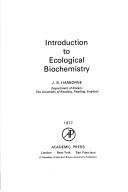| Listing 1 - 9 of 9 |
Sort by
|
Book
ISBN: 0720471338 0444106049 9780720471335 Year: 1974 Volume: 32 Publisher: Amsterdam North-Holland Publishing Company
Abstract | Keywords | Export | Availability | Bookmark
 Loading...
Loading...Choose an application
- Reference Manager
- EndNote
- RefWorks (Direct export to RefWorks)
Animal biochemistry --- 577.19 --- Pheromones and phytocins --- Animal communication. --- Pheromones. --- 577.19 Pheromones and phytocins
Book
ISBN: 0716750368 9780716750369 Year: 1992 Publisher: New York (N.Y.): Scientific American library
Abstract | Keywords | Export | Availability | Bookmark
 Loading...
Loading...Choose an application
- Reference Manager
- EndNote
- RefWorks (Direct export to RefWorks)
Animal psychology and neurophysiology --- Feromonen --- Pheromones --- Pheromomes --- Chemoreceptor Cells --- Pheromones. --- 577.19 --- Hormones --- Semiochemicals --- Sex recognition (Zoology) --- Synomones --- Allelochemicals --- Allomones --- Ectohormones --- Kairomones --- Animal Communication --- Chemotactic Factors --- Pheromones and phytocins --- Internal medicine --- Physiology. --- Endocrinology --- Endocrinology. --- 577.19 Pheromones and phytocins --- Allelochemical --- Allomone --- Kairomone --- Pheromone --- Semiochemical

ISSN: 03401022 ISBN: 3540208283 9783540208280 3540398686 Year: 2004 Volume: 239 Publisher: Berlin Springer
Abstract | Keywords | Export | Availability | Bookmark
 Loading...
Loading...Choose an application
- Reference Manager
- EndNote
- RefWorks (Direct export to RefWorks)
Semiochemicals --- Pheromones --- Analysis --- Analysis. --- chemistry. --- 577.19 --- Pheromones and phytocins --- Chemistry. --- Organic chemistry. --- Agriculture. --- Biochemistry. --- Organic Chemistry. --- Biochemistry, general. --- 577.19 Pheromones and phytocins --- Organic chemistry --- Chemistry --- Biological chemistry --- Chemical composition of organisms --- Organisms --- Physiological chemistry --- Biology --- Medical sciences --- Farming --- Husbandry --- Industrial arts --- Life sciences --- Food supply --- Land use, Rural --- Composition --- Semiochemicals - Analysis --- Pheromones - Analysis

ISSN: 03401022 ISBN: 9783540314776 3540213082 9783540213086 3540314776 Year: 2004 Volume: 240 Publisher: Berlin Springer
Abstract | Keywords | Export | Availability | Bookmark
 Loading...
Loading...Choose an application
- Reference Manager
- EndNote
- RefWorks (Direct export to RefWorks)
General biochemistry --- Organic chemistry --- biochemie --- organische chemie --- landbouw --- Agriculture. Animal husbandry. Hunting. Fishery --- Chemistry. --- Organic Chemistry. --- Biochemistry, general. --- Agriculture. --- Chemistry, Organic. --- Biochemistry. --- Chimie --- Chimie organique --- Agriculture --- Biochimie --- Semiochemicals --- Pheromones --- Analysis. --- chemistry. --- Chemistry --- General and Others --- 577.19 --- 577.19 Pheromones and phytocins --- Pheromones and phytocins --- Organic chemistry. --- Biological chemistry --- Chemical composition of organisms --- Organisms --- Physiological chemistry --- Biology --- Medical sciences --- Farming --- Husbandry --- Industrial arts --- Life sciences --- Food supply --- Land use, Rural --- Composition --- Semiochemicals - Analysis. --- Pheromones - Analysis. --- Pheromones - chemistry.
Book
ISBN: 2225436045 9782225436048 Year: 1976 Volume: 7 Publisher: Paris Masson
Abstract | Keywords | Export | Availability | Bookmark
 Loading...
Loading...Choose an application
- Reference Manager
- EndNote
- RefWorks (Direct export to RefWorks)
General biochemistry --- General ecology and biosociology --- Environmental chemistry --- Chimie de l'environnement --- 581.19 --- 581.524.1 --- 591.58 --- 577.19 --- Chemical constituents of plants --- Theoretical and general questions. Mutual influences of living organisms --- Communication and expression by sound or ultrasonic vibrations, mime or other signals, smell, touch or chemical sense (chemoreception) --- Pheromones and phytocins --- ECO Ecology --- chemical ecology --- ecology --- insects --- plants --- 591.58 Communication and expression by sound or ultrasonic vibrations, mime or other signals, smell, touch or chemical sense (chemoreception) --- 581.524.1 Theoretical and general questions. Mutual influences of living organisms --- 581.19 Chemical constituents of plants --- 577.19 Pheromones and phytocins --- Ecology. --- Pheromones --- Steroids --- Toxins
Multi
ISBN: 9073035392 Year: 1996 Publisher: Maastricht Natuur en Techniek
Abstract | Keywords | Export | Availability | Bookmark
 Loading...
Loading...Choose an application
- Reference Manager
- EndNote
- RefWorks (Direct export to RefWorks)
Animal psychology and neurophysiology --- Hygiene. Public health. Protection --- Glandular physiology --- Genetics --- 591.58 --- 577.19 --- #SBIB:309H53 --- $?$96/02 --- 001 wetenschappen --- 54 chemie --- 591.185.34 --- 632.936.2 --- biologie --- dierengedrag --- geuren --- 594 --- chemie --- chemische communicatie --- dierenethologie --- dierkunde --- exacte wetenschappen --- feromonen --- gedrag --- geurstoffen --- insecten --- prostaglandines --- reuk --- zoogdieren --- Communication and expression by sound or ultrasonic vibrations, mime or other signals, smell, touch or chemical sense (chemoreception) --- Pheromones and phytocins --- Niet-verbale communicatie --- Biochemistry --- History of medicine --- Molecular biology. --- Veterinary sciences and medicine --- Dierfysiologie --- Feromonen --- 20th century --- Netherlands --- Biochemistry. --- Veterinary sciences and medicine. --- Dierfysiologie. --- Feromonen. --- 20th century. --- Netherlands. --- 577.19 Pheromones and phytocins --- 591.58 Communication and expression by sound or ultrasonic vibrations, mime or other signals, smell, touch or chemical sense (chemoreception) --- Communicatie (zoologisch) : geuren --- 632.936 --- 583 --- zintuigen --- parfum --- zoologie

ISBN: 0691092737 1282259334 9786612259333 1400830834 0691004889 9781400830831 9780691004884 Year: 2009 Publisher: Princeton, NJ
Abstract | Keywords | Export | Availability | Bookmark
 Loading...
Loading...Choose an application
- Reference Manager
- EndNote
- RefWorks (Direct export to RefWorks)
The tobacco plant synthesizes nicotine to protect itself from herbivores. The female moth broadcasts sex pheromones to attract a mate, while a soldier ant deploys an alarm pheromone to call for help. The carbon dioxide on a mammal's breath beckons hungry ticks and mosquitoes, while a flower's fragrance speaks to the honey bee. Indeed, much of the communication that occurs within and between various species of organisms is done not by sight, sound, or touch, but with chemicals. From mating to parenting, foraging to self-defense, plant and animal activities are accomplished largely by the secretion or exchange of organic chemicals. The fascinating and fast-developing science that encompasses these diverse phenomena is introduced here, by William Agosta, in a series of remarkable stories absolutely accessible to the general reader yet revelatory to chemists and biologists. Among Agosta's characters are the organisms that steal, counterfeit, or interpret the chemical signals of other species for their own ends. We learn of seeds that mimic ant odors to facilitate their own dispersion and flies that follow the scent of truffles to lay their eggs. We read about pit vipers that react in terror when their flicking tongues detect a king snake, and slave-making ants incapable of finding their own food. And we meet ice-age people who ate birch fungus to relieve whipworms and early human hunters who used the urine of wolves to maneuver deer to favorable sites. Agosta also chronicles the rapid development of the applied science that makes use of chemical ecology. As researchers deepen our understanding of the biological world, they are making economically significant discoveries (such as enzymes that remain stable in extreme heat), finding ways to reduce our reliance on manufactured pesticides, identifying new uses for traditional medicines, and developing sophisticated new pharmaceuticals effective in treating malaria and several cancers. On the horizon are antiviral agents derived from the chemical defenses of marine species. From the exploits of flies to the high-stakes effort to cure human disease, Agosta's tour of chemical ecology grants any reader entrance to the invisible realm where chemistry determines life and death.
574 --- 57.044 --- 57.026 --- 577.19 --- 591.58 --- 581.57 --- 581.57 Means of protection. Means of attraction. Adaptations for self-preservation --- Means of protection. Means of attraction. Adaptations for self-preservation --- 591.58 Communication and expression by sound or ultrasonic vibrations, mime or other signals, smell, touch or chemical sense (chemoreception) --- Communication and expression by sound or ultrasonic vibrations, mime or other signals, smell, touch or chemical sense (chemoreception) --- 577.19 Pheromones and phytocins --- Pheromones and phytocins --- 57.026 Social processes and behaviour. --- Social processes and behaviour. --- 57.044 Chemical factors --- Chemical factors --- 574 General ecology. Biocoenology. Hydrobiology. Biogeography --- General ecology. Biocoenology. Hydrobiology. Biogeography --- Chemoecology --- Ecologie chimique --- Chemical ecology. --- Ecology --- Metabolites --- Chemosensory ecology

ISBN: 0123246709 9780123246707 Year: 1977 Publisher: London Academic Press
Abstract | Keywords | Export | Availability | Bookmark
 Loading...
Loading...Choose an application
- Reference Manager
- EndNote
- RefWorks (Direct export to RefWorks)
Phytochemistry. Phytobiochemistry --- General ecology and biosociology --- Ecology --- Environmental chemistry --- Biochemistry --- Ecologie --- Chimie de l'environnement --- Biochimie --- 581.5 --- 581.19 --- 591.58 --- 581.574 --- 577.19 --- Chemistry, Environmental --- Chemistry --- Balance of nature --- Biology --- Bionomics --- Ecological processes --- Ecological science --- Ecological sciences --- Environment --- Environmental biology --- Oecology --- Environmental sciences --- Population biology --- Biological chemistry --- Chemical composition of organisms --- Organisms --- Physiological chemistry --- Medical sciences --- Habits of plants. Plant behaviour. Plant ecology. Plant ethology. The plant and its environment. Bionomics of plants --- Chemical constituents of plants --- Communication and expression by sound or ultrasonic vibrations, mime or other signals, smell, touch or chemical sense (chemoreception) --- Means of attraction. Means of fascination --- Pheromones and phytocins --- Composition --- Biochemistry. --- Ecology. --- Environmental chemistry. --- 577.19 Pheromones and phytocins --- 581.574 Means of attraction. Means of fascination --- 591.58 Communication and expression by sound or ultrasonic vibrations, mime or other signals, smell, touch or chemical sense (chemoreception) --- 581.19 Chemical constituents of plants --- 581.5 Habits of plants. Plant behaviour. Plant ecology. Plant ethology. The plant and its environment. Bionomics of plants

ISBN: 0123246865 0123246857 Year: 1993 Publisher: London : Academic Press,
Abstract | Keywords | Export | Availability | Bookmark
 Loading...
Loading...Choose an application
- Reference Manager
- EndNote
- RefWorks (Direct export to RefWorks)
Physiologie végétale --- Plant physiology --- Plante --- plants --- Résistance aux facteurs nuisibles --- Resistance to injurious factors --- Pollinisation --- Pollination --- Pollinisateur --- Pollinators --- Phytoécologie --- plant ecology --- Substance toxique --- toxic substances --- Extrait d'origine végétale --- Plant extracts --- Phéromone --- Pheromones --- Insecta --- Comportement alimentaire --- Feeding habits --- Vertèbre --- vertebrates --- Biochimie --- biochemistry --- Relation hôte parasite --- Host parasite relations --- Selection naturelle --- Natural selection --- Préférence alimentaire --- Feeding preferences --- 574 --- 577.19 --- 581.19 --- 581.574 --- 591.58 --- 577.1 --- General ecology. Biocoenology. Hydrobiology. Biogeography --- Pheromones and phytocins --- Chemical constituents of plants --- Means of attraction. Means of fascination --- Communication and expression by sound or ultrasonic vibrations, mime or other signals, smell, touch or chemical sense (chemoreception) --- Chemical bases of life. Biochemistry and bio-organic chemistry generally --- Environmental chemistry. --- Biochemistry. --- ECO Ecology --- climates --- co-evolution --- ecology --- feeding preferences --- hormones --- interactions --- plant toxins --- pollination --- 577.1 Chemical bases of life. Biochemistry and bio-organic chemistry generally --- 591.58 Communication and expression by sound or ultrasonic vibrations, mime or other signals, smell, touch or chemical sense (chemoreception) --- 581.574 Means of attraction. Means of fascination --- 581.19 Chemical constituents of plants --- 577.19 Pheromones and phytocins --- 574 General ecology. Biocoenology. Hydrobiology. Biogeography --- Adaptation biochimique
| Listing 1 - 9 of 9 |
Sort by
|

 Search
Search Feedback
Feedback About UniCat
About UniCat  Help
Help News
News